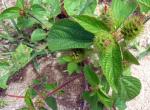skin infection
Acalypha arvensis(In territories with significant traditional TRAMIL use)
Significant uses found by the TRAMIL surveys leaves, decoction, applied locally1 |
Recommandations
Preparation and posology References |
According to published and other information: Use for skin infections is classified as REC, based on the significant traditional use documented in the TRAMIL surveys, and on available published scientific information. Do not ingest, due to danger of cyanide poisoning. If poisoning occurs, seek medical attention. For topical application, strict hygiene measures should be observed in order to avoid contamination or additional infection. Should there be a notable worsening of the patient’s condition, or should the skin infection last more than 5 days, seek medical attention. |
For skin infections: Make an decoction, boiling for 5-10 minutes 30 g of fresh leaf in 1 liter of water. Let sit, and filter. Wash injury with purified water and soap, and apply the infusion in the form of a wash or a compress to the affected area 3 times a day. |
1 GIRON L, 1988 Encuesta TRAMIL (Costa atlántica). Centro Mesoamericano de Tecnología CEMAT, Guatemala, Guatemala. 2 DUKE JA, 1992 Handbook of phytochemical constituents of GRAS herbs and other economic plants. Boca Raton, USA: CRC Press. 3 CACERES A, GIRON L, ALVARADO S, TORRES M, 1987 Screening of antimicrobial activity of plants popularly used in Guatemala for the treatment of dermatomucosal diseases. J Ethnopharmacol20(3):223-237. 4 PERUMAL SAMY R, IGNACIMUTHU S, RAJA DP, 1999 Preliminary screening of ethnomedicinal plants from India. J Ethnopharmacol66(2):235-240. 5 FREIXA B, VILA R, VARGAS L, LOZANO N, ADZET T, CANIGUERAL S, 1998 Screening for antifungal activity of nineteen Latin American plants. Phytother Res 12(6): 427-430. 6 POULTON J, KEELER R, TU T, Eds., 1983 Handbook of natural toxins 1. New York, USA: Marcel Dekker. 7 NAHRSTEDT A, 1987 Recent developments in chemistry, distribution and biology of the cyanogenic glycosides. In: Hostettmann K, Lea P, Eds. Biologically Active Natural Products. Oxford, England: Oxford Science Publications:p167-184,213-234. 8 CARRICONDE C, CARRICONDE D, 1987 De Volta às raízes. Impresos (periódicos) del Centro Nordestino de Medicina Popular de Recife, Brasil. 9 SOLIS PN, RODRIGUEZ N, ESPINOSA A, GUPTA MP, 2004 Estudio fitoquímico de algunas plantas TRAMIL con usos en Martinica. Informe TRAMIL. Centro de Investigaciones Farmacognósticas de la Flora Panameña CIFLORPAN, Facultad de Farmacia, Universidad de Panamá, Panamá, Panamá. |
